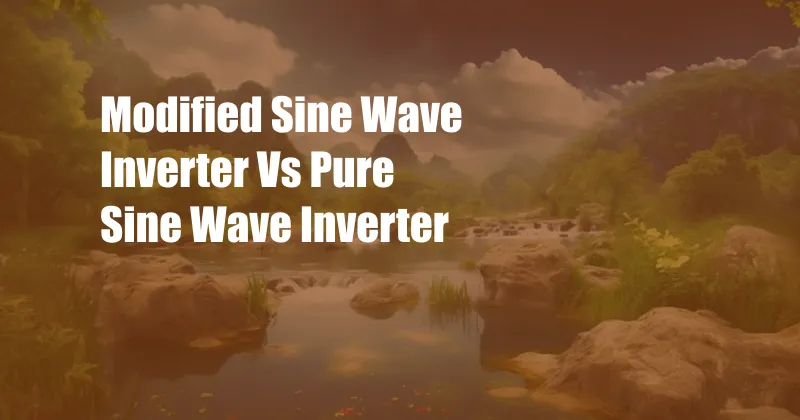
Modified Sine Wave Inverter vs. Pure Sine Wave Inverter: Unraveling the Differences
In the realm of electrical power, understanding the nuances between inverter types is crucial for optimizing performance and ensuring the longevity of sensitive electronic devices. Inverters, devices that convert DC power from batteries into AC power, play a vital role in portable energy systems. Amidst the various inverter technologies available, modified sine wave inverters and pure sine wave inverters stand out as the two most common choices.
To embark on this exploration, let us consider a relatable scenario. Imagine yourself embarking on a blissful camping trip, seeking respite from the hustle and bustle of everyday life. As you set up your campsite, you realize the crucial need for a power source to charge your electronic companions, from smartphones and laptops to portable fridges. Choosing the right inverter becomes paramount to ensure the smooth functioning of these gadgets.
Modified Sine Wave Inverter: A Budget-Friendly Alternative
For those seeking a budget-friendly option, modified sine wave inverters present themselves as a viable solution. These inverters produce a staircase-like waveform, approximating the smooth sine wave found in standard household AC power. While not as refined as pure sine wave inverters, modified sine wave inverters can adequately power many electronic devices, including lights, fans, and small appliances.
The functionality of modified sine wave inverters stems from their ability to provide AC power within an acceptable voltage range. However, certain sensitive electronics, such as medical equipment, audio systems, and precision instruments, may be prone to interference or malfunction when connected to modified sine wave inverters. This is due to the presence of harmonics in the modified waveform, which can create electromagnetic interference (EMI) and disrupt the delicate circuitry of these devices.
Pure Sine Wave Inverter: The Gold Standard for Sensitive Electronics
In contrast to modified sine wave inverters, pure sine wave inverters generate a waveform that closely resembles the sinusoidal curve of household AC power. This meticulously crafted waveform ensures compatibility with even the most sensitive electronic devices, eliminating the risk of interference or damage.
Pure sine wave inverters are particularly well-suited for powering devices that rely on precision timing, such as computers, printers, and medical equipment. They also excel in applications where high-quality audio reproduction is paramount, preventing unwanted noise or distortion in audio systems and home theaters. Additionally, pure sine wave inverters minimize energy loss, resulting in a higher efficiency than their modified sine wave counterparts.
Tips and Expert Advice for Choosing the Right Inverter
Navigating the decision between modified sine wave inverters and pure sine wave inverters requires careful consideration of your specific needs and budget. Here are some tips and expert advice to guide your choice:
- Assess Your Device Requirements: Determine the types of electronic devices you intend to power with the inverter. If you primarily use basic appliances and less sensitive electronics, a modified sine wave inverter may suffice. However, if your setup includes sensitive equipment or audio systems, a pure sine wave inverter is highly recommended.
- Consider Energy Efficiency: Pure sine wave inverters exhibit higher efficiency than modified sine wave inverters. While this difference may not be significant for occasional use, it becomes more pronounced with prolonged usage or when powering energy-intensive devices.
- Evaluate Your Budget: Modified sine wave inverters are typically more affordable than pure sine wave inverters. If you are on a tight budget and only require basic AC power for non-sensitive devices, a modified sine wave inverter can be a cost-effective option.
Frequently Asked Questions About Inverters
- Q: Can I use a modified sine wave inverter to power my laptop?
A: Yes, most laptops can operate on modified sine wave power without experiencing any issues. - Q: What is the main advantage of a pure sine wave inverter?
A: Pure sine wave inverters provide cleaner and more reliable power, minimizing interference and maximizing compatibility with sensitive electronic devices. - Q: Which type of inverter is best for powering medical equipment?
A: For medical equipment, it is strongly recommended to use a pure sine wave inverter to ensure proper functioning and patient safety. - Q: How do I determine the size of inverter I need?
A: Calculate the total wattage of the devices you intend to power simultaneously and add a 20-30% buffer for efficiency and future expansion.
Conclusion: Making an Informed Decision
Selecting the right inverter for your needs requires careful consideration of the type of devices you intend to power, your budget, and the level of power quality you require. Modified sine wave inverters offer a budget-friendly option for basic applications, while pure sine wave inverters provide the highest level of compatibility and power quality for sensitive electronics. By understanding the key differences between these inverter types, you can make an informed decision that meets your specific requirements.
If you are still unsure which type of inverter is best for you, feel free to leave a comment below or reach out to an electrical professional for personalized guidance. Let us delve further into the world of inverters and empower you with the knowledge to make the right choice for your next adventure.